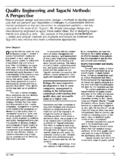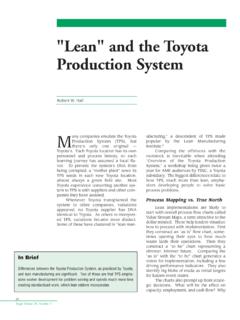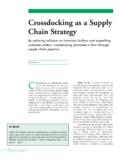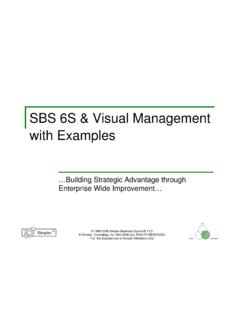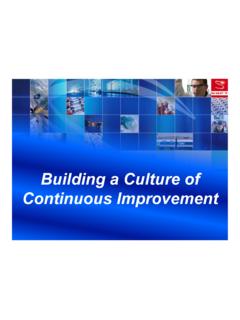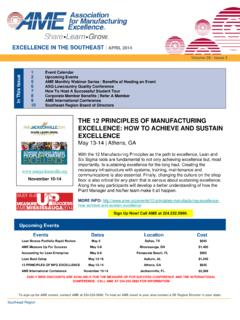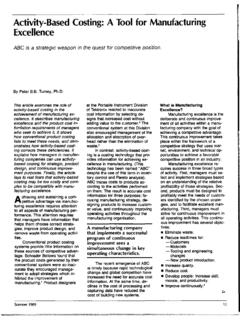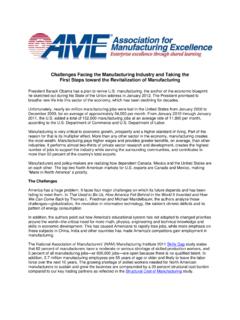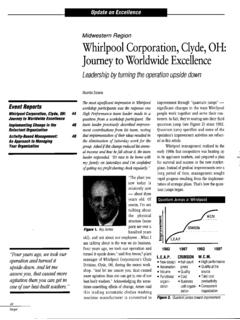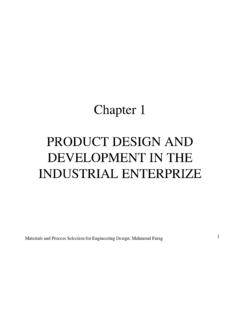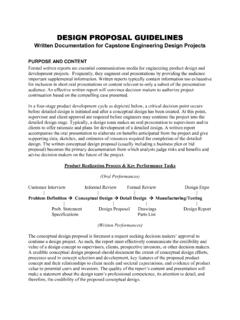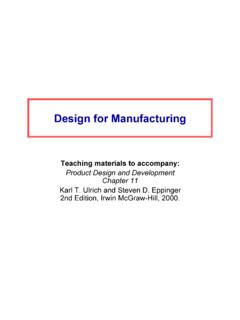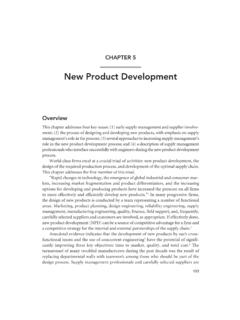Transcription of The Toyota Product Development System
1 This appears to be the most compre-hensive book to date on the ToyotaProduct Development System (TPDS). Morgan and Liker call itLean Product Development System ,but it is really Toyota s, notAmerican lean. It is the result oflengthy research at the University ofMichigan headed by the late AlanWard, to whom the authors givegreat credit. All the examples com-pare vehicle Development betweenToyota and North American carcompanies, but by careful readingand reflection, anyone interested inproduct Development can learn howthe principles apply to them. Thebook illustrates 13 principles of leanproduct amount of operationalkaizen can overcome the wastelocked up in a poor design . Theintended customers may not bepleased either.
2 Toyota s expertisedeveloping new products is well rec-ognized. Although not known forstyling pizzazz, Toyota has fewerproblems with recalls than competi-tors, and its leadtime for a derivativemodel designed on an existing plat-form has been as low as ten average is 12-15 months com-pared with 24 months in NorthAmerica. The North American com-panies leadtime is down from 36-40months in the 1990s, so everyone isprogressing, and shorter leadtimesmean more new models. Since2003, the automotive industry hasannually launched 60 or more newmodels each year into the NorthAmerican market alone. No wonderyou can t identify all the cars any-more. The Toyota Product Develop-ment System , interacting with itsvaunted production System , hasbecome a big advantage to Toyota ,because productivity is only onefactor in overall waste.
3 Forinstance, the 2006 Harbour Reportshows several other assemblyplants in North America to be moreproductive than Toyota s, but Ford sAtlanta Taurus Assembly, toppingHarbour s list, is also on Ford s clo-sure list. By designing quality in,then building it in, plus creatingflexibility to change model mixeswhile minimizing spending on toolsand equipment, Toyota s overalladvantages offset small differencesin assembly productivity. Within Toyota , experiencewith the production systemremains bedrock training foralmost everyone having otherresponsibilities. For example, everynew Toyota engineer does a stint inproduction and at a dealership,probably selling vehicles. Todesign them to be made and sold,you need first-hand experiencewith the processes you are design -ing for.
4 However, Toyota s greatestemphasis with engineers careerdevelopment is technical want T-shaped people, engi-neers with great technical expert-ise, but also having the breadth foreasy collaboration among manyfunctions as a normal part of dailywork developing vehicles. Well-known is that Toyotaproduct Development relies on achief engineer (CE) for each car, A3papers codifying technical knowl-edge, and selection of designs fromtested data using trade-off curves,with designs jelled at the last possi-ble time from among many alterna-tives. The chief engineer orches-trates a vehicle s design , and isresponsible for design , in a nutshell, is set-baseddesign engineering. A few benefits of TPDS can bederived by copying its techniques,but the entire System defies quick,easy emulation.
5 It is based on a dif-ferent concept of Product design anda different organizational philoso-phy. The System developed overdecades. It is still evolving. A fewHR tweaks plus adopt-a-techniquewon t quickly replicate a System thatcan fully compete with instance, Toyota hasinvested years in developing eachengineer, technically and otherwise,in their System to continuouslyimprove collective knowledge, andin their processes for Review51 Fourth Issue 2006 The Toyota Product Development SystemJames M. Morgan and Jeffrey K. LikerProductivity Press, New York, 2006, 363 that turnover will be verylow, it s a people-centered discipline of the A3 papers andthe mentoring of senior engineersdevelop tacit knowledge. Aided bythe technical archives and processchecklists, this base of experienceprompts someone to ask the rightquestions throughout a designprocess.
6 By taking time up front toreview sets of tested design alterna-tives, most of the time late in theprocess is value-added work tolaunch the vehicle, not and engineering changesare minimal because the systemstimulates continuous improvementof knowledge and skills. Attentionto that, despite the pressures ofimmediate projects, lets every prod-uct Development start further downthe learning curve more newlearning, less those ambitious to over-haul their Product developmentprocesses, a brief review cannotconvey the lessons of this book. Asecond or third re-read of some ofthe writing is worthwhile. Many ofthese ideas have to be digestedslowly because TPDS is an inter-locked System , not a collection ofdisconnected techniques.
7 A few Japanese terms may benew; kentou, for instance, the front-end study phase of new productdevelopment. So many people areinvolved in kentouthat most project doers become familiar with a proj-ect and its customer needs at thisstage. They begin thinking throughknotty problems before project exe-cution begins. That s well beforeNorth American lean companies startto refine a design using term is mizen bouchi,meaning designed-in quality. Thislabel covers a host of techniquesthat over time add up to continuousimprovement of Product design andprocess quality, becoming embed-ded in the culture how things getdone at Toyota . Although hard to fully appreci-ate without explanatory examples, aquick summary of the 13 principlesconstituting the framework onwhich Morgan and Liker hang TPDS give a flavor for the book:1.
8 Establish customer-defined value to separate value-added from Front-load the Product design process while there is design space to thoroughly explore alternative Create a leveled Product develop-ment process Use rigorous standardization to reduce variation, thereby creatingboth flexibility and predictable Develop a chief engineer systemto integrate Development from start to Organize to balance functional expertise and cross-functional integration (more is involved here than your father s matrix management).7. Develop towering technical com-petence in all Fully integrate suppliers into the Product Development Build in learning and Build a culture to support excel-lence and relentless Adapt technology to fit your people and your Align your organization throughsimple, visual Use powerful tools for standard-ization and organizational by Robert W.
9 Hall, editor-in-chief,Target Magazine. 2006 AME For information on reprints, contact:Association for Manufacturing ExcellenceBook Review52 Target Volume 22, Number 4 WILLYOUBEABLETOINCOMPETEAGREENSOCIETY?
